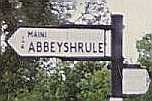 Abbeyshrule:
Abbeyshrule:
John Jones' Birthplace

The ruins of the Abbey of Shrule, from which Abbeyshrule takes its name.
 Abbeyshrule:
Abbeyshrule:

The ruins of the Abbey of Shrule, from which Abbeyshrule takes its name.
Anyone who has hung out in an Irish pub in America or elsewhere, as your author has been known to do, has probably heard "The Rising of the Moon"; but our Jones kin may not all know the close links this song has to our own family origins in Ireland. Our Jones family should know that "the old spot by the river" and "that singing river" refer to the River Inny (Eithne in Gaelic), in the vicinity of the little village of Abbeyshrule in County Longford. The dominant local clan were the O'Farrell, and so "Sean O'Farrell", addressed several times in the song, is kind of like "John Smith" in the area, a typical name for a local patriot. John Keegan Casey, who supposedly wrote the great rebel song when he was only 14 years old, came from the area. So did my great-grandfather John Jones, though his father had come later than the events of 1798 that the song refers to (though Casey wrote the song in the 19th century). His mother was a local, however, and her ancestors may well have been around during the Longford Rising of 1798, the subject of the song.Ah, then tell me, Sean O'Farrell, where the gathering is to be?
In the old spot by the river, right well known to you and me.
One more word for signal token: whistle up the marching tune;
For the pikes must be together by the rising of the moon.All along that singing river, that dark mass of men was seen;
High above their shining weapons hung their own immortal green...The Rising of the Moon, John Keegan Casey
These pages include the account of my 1987 trip that I wrote soon after it, a more lightweight account of the joys of dealing with octogenarians in Abbeyshrule called Touring with Tom, information about Mill Lane where our Joneses seem to have lived, and, for a full treatment of what we know about the Joneses in Abbeyshrule, a link to my David Jones page.
Our ancestor John Jones (1828-1914) was born in Abbeyshrule, County Longford, Ireland. I'm not certain, but I may be the only American Jones descendant to get to Abbeyshrule so far -- I went there in 1987 -- and so I thought I'd put up a few pages dealing with what I learned then, pictures of the place, etc. I also got to Fannie Reilly's hometown of Athlone and will put that up later, but Athlone is a major city with its own tourist bureaus and such, while Abbeyshrule is a bit more obscure. I visited in June of 1987 -- twice actually, about three days apart, though the second visit was mostly for additional photography, and my "Notes on Abbeyshrule" deal almost entirely with the first visit -- and these pages include both my original notes of that time and what I have learned since, as well as photos and maps.
Abbeyshrule (Mainistir Shruthla in Gaelic, pronounced,
I think, something like "minster shrula", but nobody in these parts speaks
Gaelic) in 1987 was a tiny place, a few houses, a post office, a Catholic
church, and considerable rural hinterland, but it actually had and still
has a bit of a national reputation in Ireland for three reasons: its airport,
the Royal Canal, and the local pub/nightclub/B&B, the Rustic Inn, which
in the 80s at least had a reputation as a major venue for US country and
Western music in Ireland. More on these in a bit. Looking at old
maps from the British period it doesn't seem to have been any bigger in
the early 20th century, and the only main structure no longer there was
a police barracks. In the early 19th century, though, it was a town on
the important Royal Canal from Dublin to the Shannon, and apparently much
bigger. The famine destroyed Ireland in ways that we can barely understand:
County Longford as a whole had a population in 1841 of 115,000; by 1851
it was only 82,000, and by 1861 only 71,000. In 1991 it was a county of
only 30,000 people. Now that Ireland is the "Celtic Tiger" and enjoying
a major industrial and computer boom, that may be changing, but I'm not
so sure: Longford has few major towns and is mostly rural and agricultural.
The big growth is in Dublin, Limerick, etc.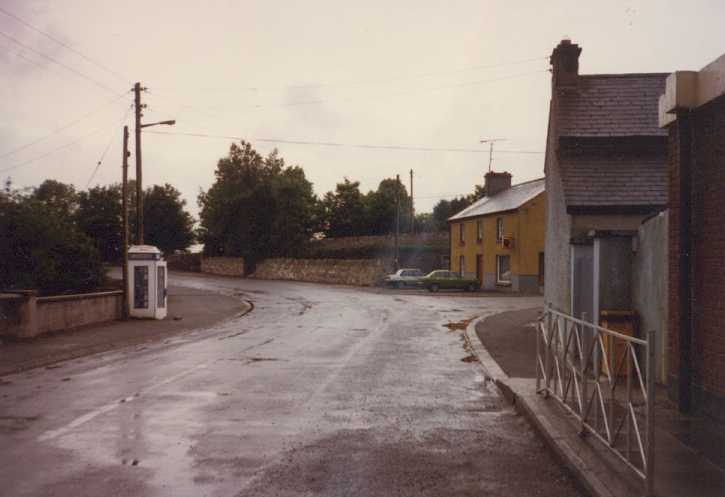
Abbeyshrule's population I have not been able to determine then or now, but it presumably lost population in proportion to the rest of the county. As we'll see, the Royal Canal probably accounted for a Welshman named David Jones turning up in Abbeyshrule and marrying a local girl.
Abbeyshrule (the picture is of beautiful downtown
Abbeyshrule, the main crossroads at the center of town) is roughly 100
miles from Dublin (I base this on Mullingar being 87 miles, and Abbeyshrule
appearing on the map to be about 10-15 miles beyond Mullingar), and in
1987 that was maybe two hours or more driving on some main roads and some
small two-lanes, depending on how good you are driving on the left
side of the road with a steering wheel on the right side of the car. In
1987 I wasn't very good at this, since the very first time I tried it was
when my rental car was delivered to my Dublin hotel and I set out for Abbeyshrule,
and got my first try at left-side driving during Dublin rush hour, so I
probably took longer to get there than was necessary. The roundabouts (traffic
circles) create a particular dyslexia in you as you try to remember who
you're supposed to yield to and which way you're supposed to go. At least
in 1987 there was no public transportation that went to Abbeyshrule: no
buses, or other way to get there except to rent a car. I assume that's
still the case but it has been 15 years now and I could be wrong. (Text
continues below the map.)
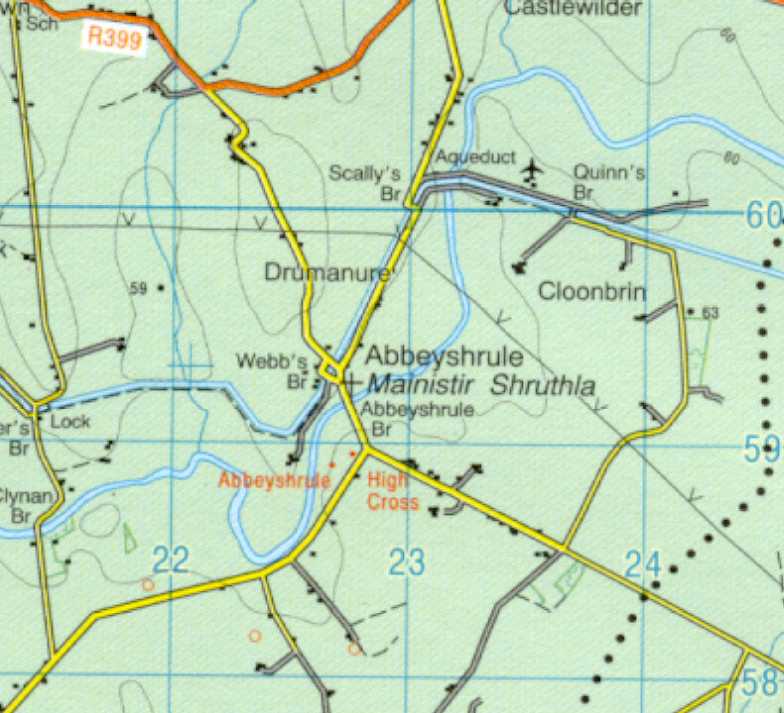 |
On the map above, the River Inny is the blue line to the right of the town of Abbeyshrule, the Royal Canal is the blue line to the left. North of town, marked "Aqueduct" on the map, is the aqueduct which carries the canal over the river. Near there is the airport, one of Abbeyshrule's oddities: a tiny village with an airport which is actually rather famous. Being located in the near middle of Ireland in flat bog country, it is apparently a good little airfield and once a year has a major air show/rally for (I think mostly private) aircraft enthusiasts. So the "Abbeyshrule airshow" is one of the reasons some people elsewhere in Ireland have heard of Abbeyshrule.
I cannot find the population of Abbeyshrule after several web searches, but in 1987 I don't think it could have been more than a few dozen -- 50 maximum? -- living in the village proper, and in my 1987 report linked below I said that the farmsteads around it might add up to 200 or so. Now, as also back in the 19th century, the parish of Abbeyshrule, and the townland (roughly but not exactly equivalent to "township" in the US) were bigger than the village itself. Using Griffith's Valuation and other sources for the 19th century, however, it doesn't look like post-famine Abbeyshrule was ever very big.
Abbeyshrule is in an interesting place. The River Inny, the "singing river" of The Rising of the Moon quoted above, runs past, but the Inny is a small and non-navigable stream, and in the early 19th century the Royal Canal was built to link the Shannon with Dublin and the Irish Sea. That was in that great era of canal-building, before the railroads, when canals were the main means of internal traffic. The Royal Canal reached Abbeyshrule in 1817, the date carved on the Whitworth Aqueduct north of town, where the Canal is carried over the River Inny. That may have been what brought a Jones to Abbeyshrule, as noted below.
The village had an earlier history, summarized
in the historical marker reproduced here. The old abbey of Shrule is in
ruins, having been one of those suppressed by Henry VIII, but its ruins
still stand just south of the town and a photo appears at the top of this
page. 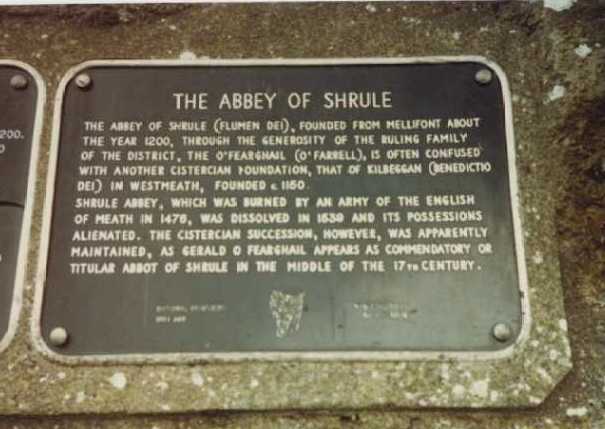
The Catholic parish today embraces Carrickedmond, a nearby town, and Abbeyshrule, and the priest is resident at Carrickedmond, though there is a modern church in Abbeyshrule. The old parish register is apparently kept there, but the Mormons have a microfilm of it. Unfortunately it does not include births during the years John Jones was born, and it is in Latin and hard to read. I learned little from borrowing the microfilm. I learned more from corresponding, some years back, with the parish priest, some of which is included in my Notes on Abbeyshrule, below.
I should note as well that the old cemetery -- right by the ruined abbey -- is impressive with its standing Celtic Crosses and such, but virtually none of the stones are legible and those who have studied them more carefully than I could say there are no Joneses visible.
According to the local historian, Ireland in its populous and prosperous days before the potato famine was a net importer of labor, and a lot of the workers on the Royal Canal were from the poorer parts of Great Britain -- including Wales. This is as good an explanation as I have ever been able to come up with as to why a Welshman ended up in Abbeyshrule, of all places, and married a local Irish girl.
We know that John Jones' father was Welsh and his mother Irish, because in both the 1900 and 1910 US census, which asked birthplaces of parents, he so listed them. Jones is of course a Welsh name, rare in Ireland, and other than our Joneses the Joneses of Longford seem all to have been Anglican. All the evidence we have points to John Jones' father being the only Jones found in Abbeyshrule in the period of his youth, David Jones, and, as noted on the page just linked, David's wife may have been named Catherine.
Abbeyshrule is also known for a couple of things besides the air show.
The Royal Canal is slowly being cleared and reconstructed for modern boaters
and hikers, and the reconstruction as of fairly recently goes to just about
Abbeyshrule, so it plays a role in the outdoors scene. And finally, there's
the Rustic Inn.
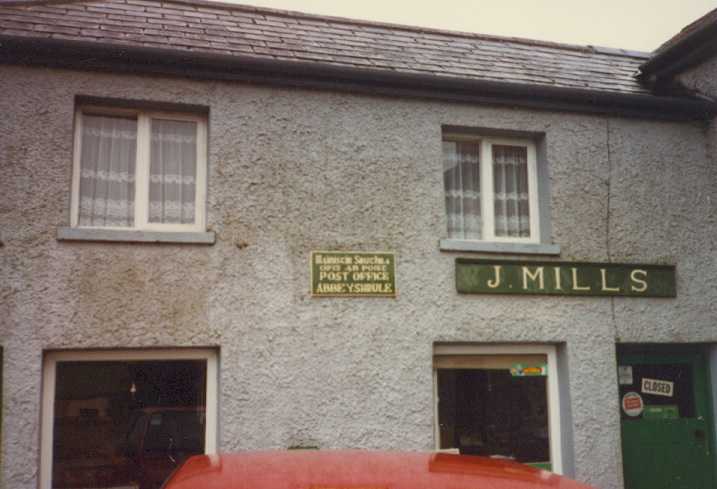
I noted in my 1987 notes that only two buildings in Abbeyshrule were
not
rustic: the modernistic church and the so-called "Rustic Inn". The Rustic
Inn is a combination hostelry (a B&B or bigger, perhaps call it a quaint
inn), entertainment center of which more in a moment, and bar, which serves
as the village pub since there is, or in 1987 was, no other local. When
I arrived in Abbeyshrule both the Post Office (photograph on this page)
and the church were closed, but the pub, of course, was open, so that was
where I went to find informants.
The specifics are in my notes, about to be linked to. But the really interesting point is that the Rustic Inn has a national reputation in Ireland as a concert site. Though 100 miles from Dublin, apparently some fairly well-known US and European performers do book there -- and still do today. While driving around in other parts of Ireland, I actually heard a concert broadcast live "from the Rustic Inn in Abbeyshrule, County Longford". The Rustic Inn then was being run by a fellow named Teddy McGoey, and his brother Charlie, as will be seen from my appended notes, turned out to be the local historian. The McGoeys still own the Rustic Inn, I gather from websites, and McGoey is one of those names that goes back to the days when Joneses were living in Abbeyshrule.
Someone out there may be saying, whoa, did you say American country
and Western music? In fact, when I drove around Ireland in 1987, in a rented
car, ranging up and down the radio channels, nobody was playing typical
American-Irish pub stuff, or Clancy Brothers, or Dubliners, or any such
stuff. The most frequent thing you heard was American C&W, which of
course is ultimately Scots, Irish, and other Celtic in its roots, and the
second most common thing you found was Euro-Pop of the Abba variety. 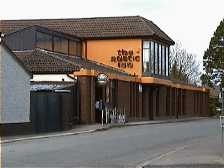 The
only places I got really traditional Irish music was in the far northwest,
in the Gaeltachta or Irish-speaking part of the country, where the Gaelic
stations broadcast a lot of Chieftains-type traditional music. But since
the explanations were given in Irish Gaelic, I didn't know what I was listening
to.
The
only places I got really traditional Irish music was in the far northwest,
in the Gaeltachta or Irish-speaking part of the country, where the Gaelic
stations broadcast a lot of Chieftains-type traditional music. But since
the explanations were given in Irish Gaelic, I didn't know what I was listening
to.
For American country, though, the Rustic Inn had a national reputation, and since then, surfing the web, I've learned it sometimes books jazz and blues musicians as well. So the one institution in the village of our Jones roots is ironically deeply into American roots music.
So if you ask your average Irishman or woman today about Abbeyshrule, they'll possibly have heard of the Rustic Inn and possibly the airshow, and if they're outdoorsy types may be into the Canal walk and such. But Abbeyshrule is otherwise a tiny place, and even these three reasons for national recognition obviously are limited to certain enthusiasts of certain fields (music, aviation, hiking/boating).
These pages include the account of my 1987 trip that I wrote soon after it, a more lightweight account of the joys of dealing with octogenarians in Abbeyshrule called Touring with Tom, and, for a full treatment of what we know about the Joneses in Abbeyshrule, a link to my now rather expanded David Jones page.